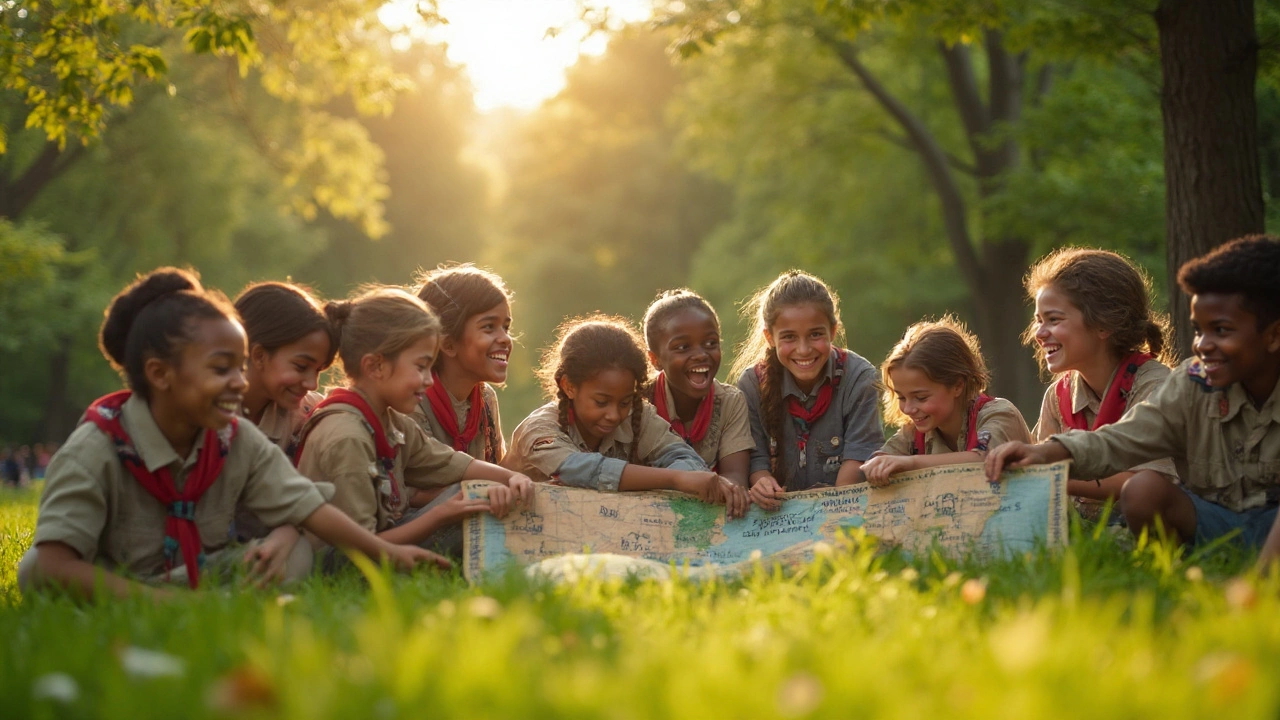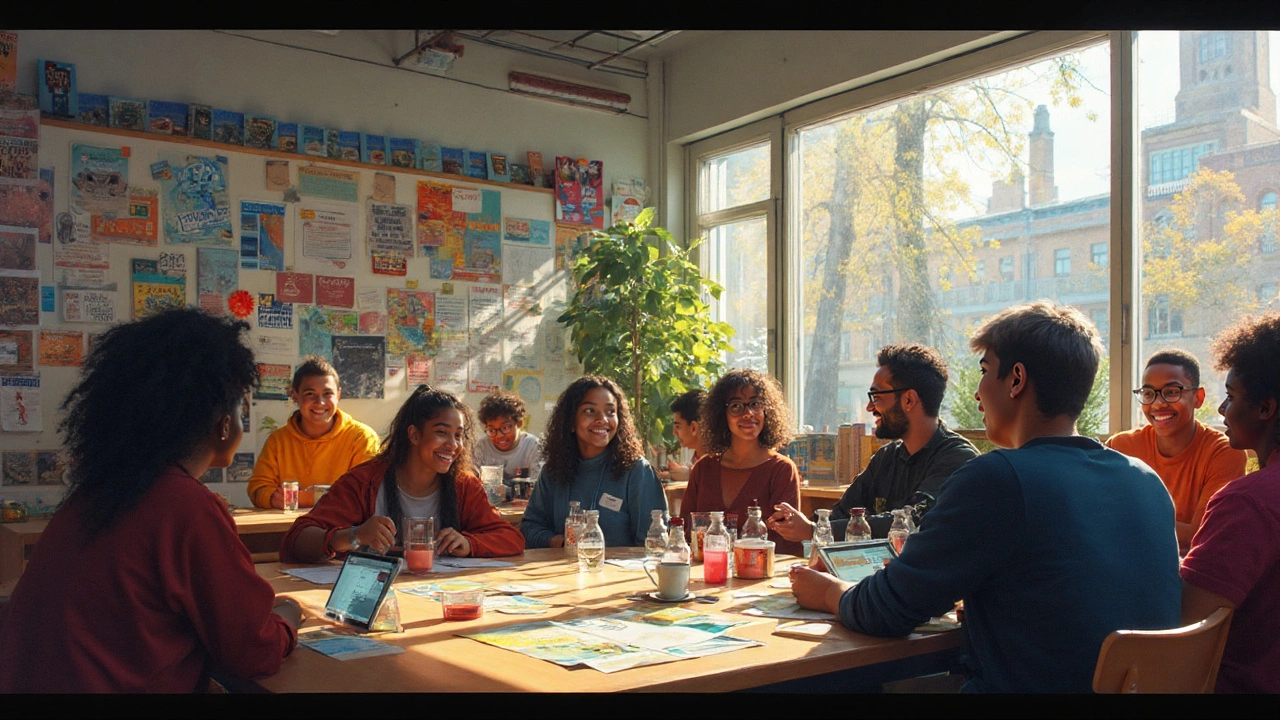The Big 6 Youth Organizations and Their Impact on Young People
 Aug, 3 2025
Aug, 3 2025
Picture this—millions of young people waking up for meetings, volunteering at parks, running social campaigns, and even representing their countries at world summits. It’s not just scattered energy. It’s the work of six mega youth organizations that reach into just about every corner of the globe. These groups have quietly shaped leaders, boosted confidence, and built a sense of community across generations. You might not know all their names, but you’ve definitely felt their influence—maybe even without realizing it.
Who Are the Big 6?
Let’s pull off the curtain—here are the Big 6 youth organizations: World Organization of the Scout Movement (WOSM), World Association of Girl Guides and Girl Scouts (WAGGGS), YMCA (World Alliance of YMCAs), YWCA (World YWCA), International Federation of Red Cross and Red Crescent Societies (IFRC), and The Duke of Edinburgh’s International Award Foundation. Each group takes a slightly different approach, but all share one mission: supporting young people to grow, give back, and lead with character. Combined, they touch the lives of more than 250 million young people worldwide. That’s not an exaggeration; WOSM itself has around 57 million members.
The World Organization of the Scout Movement, better known as Scouts, started in 1907 and is now the world’s largest youth movement. Think camping, knot-tying, and wearing neckerchiefs? It’s so much more—Scouts learn problem-solving, disaster relief, and how to be a force for good where they live. The World Association of Girl Guides and Girl Scouts swings the spotlight to empowering girls—but we’re not just talking cookies. These girls launch global anti-bullying campaigns, stand up for mental health, and fight for climate action. WAGGGS’s advocacy work helped push for gender equality in UN policy—how’s that for impact?
Then there’s the YMCA, which has been making waves since 1844. If you’ve taken a swimming lesson at your local Y or joined a gym program, you’ve tasted their worldwide approach to healthy living and social connection. Not to be confused, the YWCA, their sibling-organization, puts women and girls in charge, tackling issues like violence against women and leadership skills for tomorrow’s changemakers.
Few people know the IFRC—International Federation of Red Cross and Red Crescent Societies—counts millions of youth volunteers ready to mobilize at the drop of a hat for disaster relief, health education, and blood donation. This isn’t just emergency aid. They run youth leadership conferences and drive social innovation too. Meanwhile, The Duke of Edinburgh’s International Award Foundation (often just ‘The Award’) motivates teens with real-life challenges: volunteering, getting fit, learning new skills, and going on outdoor adventures. For many, earning that gold or silver medal is a turning point.
Something wild: These organizations don’t just work in rich countries—they’re deeply rooted in local communities across Africa, Asia, South America. During the COVID-19 pandemic, Big 6 groups hosted webinars in dozens of languages, handed out hygiene kits, set up helplines for young people overwhelmed with anxiety. The ability to adapt globally but act locally is why they’re still thriving generations later.
Their Missions and What Makes Them Unique
Sure, they all want to make young people stronger, more skilled, and kinder. But peek under the hood—each group has its own special way of getting there. Scouts and Guides are famous for learning by doing: building tents, lighting fires, or planning community projects. It’s about developing independence and teamwork. Interpret their motto “Be Prepared” any way you want—it basically means ‘I can deal with whatever life throws at me.’
The YMCA and YWCA have a wider community lens, focusing on health, wellbeing, and fighting for equality. Have you heard of the YMCA Youth Parliament, where teens actually draft and debate laws? It’s as real as it gets. And YWCA has trained tens of thousands of young women to confront violence at home, in schools, and online.
Flip to the IFRC, and things move fast: when there’s a flood in Bangladesh or an earthquake rattles Turkey, local youth Red Cross volunteers hit the ground. But during quiet times, you’ll catch them at schools teaching first aid, climate awareness, and kindness—skills that ripple outward, long after a crisis fades. There’s a true spirit of ‘youth leading youth.’
With The Duke of Edinburgh’s International Award, it’s all about setting your own pace. Participants design their own path—maybe it’s learning to cook, training for a 5K, or volunteering at an animal shelter. Those badges and certificates aren’t just for show; they give young people something to brag about on college and job applications. On a personal note, my partner Dorian was a Bronze Award winner, and it’s still a family legend how he got lost hiking, figured out his way back, and ended up helping another group along the trail.
What really makes the Big 6 unique isn’t flashy uniforms or merit badges, though those are pretty cool. It’s that they help young people practice leadership before life throws the big stuff at them. In fact, research published by the World Scout Foundation in 2023 showed former Scouts and Guides reported higher rates of civic engagement, teamwork skills, and resilience than peers who’d never joined a youth movement. These are the building blocks of strong communities.

How the Big 6 Work Together
Friendly competition aside, these six giants know they’re stronger together. In 1996, they formed the Big 6 alliance and began collaborating on global problems—think climate action, youth employment, and civic participation. Each group brings its own strengths to the table, but they pool resources, share best practices, and run massive joint campaigns.
Youth Forum events, hosted by the Big 6, draw delegates from dozens of countries to brainstorm real-life solutions for modern challenges: the digital divide, gender violence, and mental health. During these summits, young people aren’t just listening—they’re running workshops, filming documentaries, and lobbying policymakers. After COP28 in Dubai, Big 6 representatives secured meetings with UN officials to press for more youth seats at climate negotiations. Fun fact: at the 2022 Global Youth Mobilization, over 650,000 young people brainstormed recovery ideas from COVID-19, many of which local governments funded on the spot.
These organizations also work together on big days—the International Day of Peace, World Environment Day, or International Women’s Day. Their joint campaigns might look like webinars, letter-writing drives, or coordinated climate marches. Last year, Scouts, Guides, and the YMCA teamed up to plant more than a million trees in 150 countries. That’s not just photo-ops; it's measurable change.
And when disasters hit, Big 6 members don’t worry about who gets credit. In response to the Turkey earthquake, the IFRC Youth worked alongside Scouts and local Y volunteers. They distributed blankets, managed shelters, and translated for incoming international teams. There’s a built-in trust—one Big 6 group arriving in a disaster zone already knows the others’ protocols inside-out.
There’s even a shared leadership training program, rotating between cities like Nairobi, London, and New Delhi. Young people learn about UN systems, human rights law, and creative problem-solving, then go home to start new programs. It’s like a boot camp for global citizens—without the military vibe.
Why Every Young Person Should Know About the Big 6
If you grew up thinking Scouts was just for campfires or that YMCA only taught swim lessons, you’re missing the bigger picture. The Big 6 offer something almost every young person craves: a sense of belonging, a way to make a difference, and practical skills for real life. They’re also a barely-hidden launchpad into global leadership roles. Ask around in parliaments, nonprofits, or Fortune 500 boardrooms—plenty of leaders will mention time spent in one of these groups.
Here’s a tip for parents and teens: each Big 6 organization has scholarships, travel opportunities, and global exchange programs that aren’t widely advertised. Scouts and Guides often host international jamborees; the YMCA runs gap year and job shadowing experiences; the Duke of Edinburgh Award opens doors to networking with industry leaders. Some IFRC local chapters even send their top youth volunteers to Geneva for annual assemblies—imagine those selfies for your Instagram!
It’s not just about building a killer resume, though that’s a smart bonus. Youth who get involved in these organizations tend to be more adaptable, creative under pressure, and confident handling conflicts. Ask any Guide who’s had to rally a group of 10-year-olds on a muddy hike, or a Red Cross volunteer comforting a family after a house fire—that’s real experience you can’t fake in a classroom.
Worried it’s just for extroverts and overachievers? Nope. The most reserved teens often find unexpected strengths—maybe as behind-the-scenes project managers, social media whizzes, or policy researchers. I saw this firsthand running community workshops: the quiet sixth-grader who never raised her hand is now a scholarship-winning activist on clean water—thanks to lessons she picked up in Scouts.
If you’re not sure where to start, check out each Big 6’s official website or local chapters. Most have trial days or taster events so you can see what fits. Volunteering doesn’t have to mean months-long commitments either; short-term and project-based roles let you try new things without stress. And who knows? Maybe your story ends up inspiring someone else to join the adventure. After all, youth programs aren’t just about the next generation—they’re about the difference young people are making right now.
